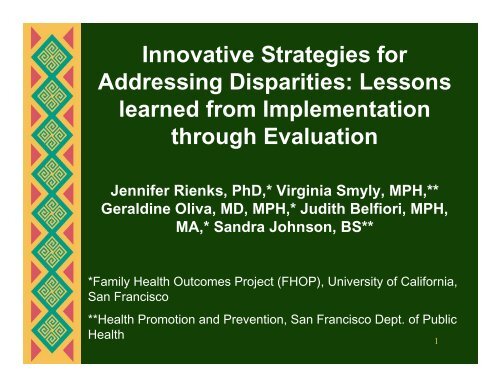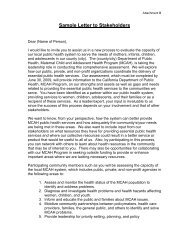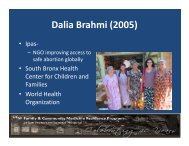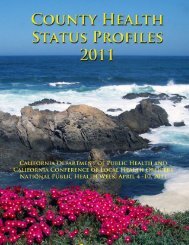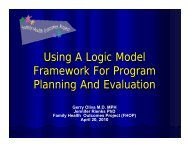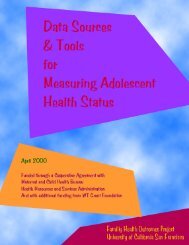Evaluation - FHOP - University of California, San Francisco
Evaluation - FHOP - University of California, San Francisco
Evaluation - FHOP - University of California, San Francisco
- No tags were found...
Create successful ePaper yourself
Turn your PDF publications into a flip-book with our unique Google optimized e-Paper software.
Innovative Strategies forAddressing Disparities: Lessonslearned from Implementationthrough <strong>Evaluation</strong>Jennifer Rienks, PhD,* Virginia Smyly, MPH,**Geraldine Oliva, MD, MPH,* Judith Belfiori, MPH,MA,* <strong>San</strong>dra Johnson, BS***Family Health Outcomes Project (<strong>FHOP</strong>), <strong>University</strong> <strong>of</strong> <strong>California</strong>,<strong>San</strong> <strong>Francisco</strong>**Health Promotion and Prevention, <strong>San</strong> <strong>Francisco</strong> Dept. <strong>of</strong> PublicHealth1
Background• <strong>San</strong> <strong>Francisco</strong> Department <strong>of</strong> PublicHealth received a REACH 2010 Grantfrom the Centers for Disease Control tocreate the SevenPrinciples for AfricanAmerican Infant Survival andCommunity Unity Project• Family Health Outcomes Project at the<strong>University</strong> <strong>of</strong> <strong>California</strong>, <strong>San</strong> <strong>Francisco</strong>contracted as the evaluator2
Seven Principles <strong>of</strong>Kwanza• Used to guide the values andstrategies <strong>of</strong> the project• Includes unity, self-determination,collective work and responsibility,cooperative economics, purpose,creativity, and faith3
Project Strategies1. Social marketing based communityawareness campaigns2. Cultural competency trainings andUndoing Racism Workshop for healthand social service providers3. Community Action Teams (CATS) toaddress underlying causes <strong>of</strong>disparities, create unity, lead /participate in community change4. Dinner and Movie Events to createcommunity connections and social4support
Awareness Campaigns:1. African American babies in SFare 2 times more likely thanwhite babies to die in the firstyear <strong>of</strong> life2. Babies sleep best on theirbacks3. Take action to stop AfricanAmerican babies from dying5
Campaigns Mediums• Ads on bus shelters, the backs <strong>of</strong> busesand inside buses in targetedneighborhoods Bus ads• Posters and hand cards distributed(delete) at <strong>San</strong> <strong>Francisco</strong> clinics, daycaresites, doctor <strong>of</strong>fices, agency waitingrooms, delete, put in notes and communityorganizations.• Church fans distributed to 50 places <strong>of</strong>worship• Radio spots were on KMEL and KBLX,radio stations popular with AfricanAmericans in the SF6
<strong>Evaluation</strong> Methodology• Time 1 and Time 2 telephone surveysconducted with African Americansbetween 18-65 years old in 4 targetneighborhoods• Time 1 telephone survey -- 804respondents prior to awarenesscampaigns• Time 2 telephone survey -- 654respondents at conclusion <strong>of</strong>awareness campaigns12
Exposure to Mediums by Age70.0%60.0%50.0%65.2%49.3%55.6%43.9%41.8%% Under 40% 40 to 65 years old49.3%45.9%40.0%34.8%30.0%20.0%10.0%0.0%Bus ads* Posters* Handouts,cards, churchfans* Percentages significantly different (p
70.0%60.0%Heard <strong>of</strong> <strong>San</strong> <strong>Francisco</strong> Black InfantMortality Disparity – Time 1 & 2Time 1 (N = 804)Time 2 (N = 654)60.4%50.0%40.0%37.6%37.3%30.0%24.4%20.0%10.0%11.9%7.0% 8.1%13.2%0.0%Repeatedly Often Occassionally Never14
Awareness <strong>of</strong> Disparity and SleepPosition• Significant increase in % <strong>of</strong> AfricanAmericans who have ever heard <strong>of</strong> SFBlack Infant Mortality Disparity (39.6% vs.62.7%, OR = 2.5, CI 2.1-3.2)• No overall significant increases inknowledge <strong>of</strong> proper sleep position(70.4% vs. 71.7%)• Significantly higher level <strong>of</strong> awareness <strong>of</strong>proper position for those exposed tocampaign vs. not exposed (79.7% vs.64.3%, OR = 2.2, CI 1.5-3.1)15
Undoing Racism Workshop• Conducted by Peoples Institute West• 227 people attended 1 <strong>of</strong> 7 workshops• Face to face interviews <strong>of</strong> 14 participants– 80% (11/14) used tools provided atworkshop to make changes in theirworkplace or community– 67% (8/12) <strong>of</strong> agencies adopted newpractices and made efforts to improveorganizational cultural competency anddecrease institutional racism.– 100% (14/14) <strong>of</strong> participants reportedtrying to take action to address or undoracism on a personal level.16
Cultural Competency TrainingComponents• Didactic session on disparities• Didactic session on cultural humility:• Small group exercises on cultural awareness• List <strong>of</strong> resources for continuing informationand education on cultural issues• Packet <strong>of</strong> client education materials and localreferral resources for clients• Article on components <strong>of</strong> culture for medicalstudents education<strong>Evaluation</strong>• Pre-Post Tests, Baseline Assessments and 3and 6 follow-up assessments17
Training Participants• 193 providers have attended 1 <strong>of</strong> 5 trainingsover 15-months• Included African-Americans, Latinos, whites,Asian and the others <strong>of</strong> mixed race/ethnicity• Included MDs (17.1%), NPs (3.1%), RNs andPHNs (19.2%), social workers (23.8%), healtheducators (13.0%), and others such asmental health pr<strong>of</strong>essionals, administrators,clinic assistants and managers (21.8%)• 82% <strong>of</strong> participants were very likely to usetools presented in workshop• 85.3% rated the training as good or excellent18
Cultural Competency Pre-PostTest FindingsIncreased confidence in their ability to:• Identify credible medical and social resourcesthat can assist with lifelong learning aboutAfrican American - 72.7%• Describe how the health provider bias <strong>of</strong> raceand culture can negatively impact the patientencounter - 58.2%• Use communication tools taught in theworkshop in clinical encounters with AfricanAmericans - 64.8%• Describe the elements <strong>of</strong> culturally competenthealth care - 66.5%• Describe the social conditions that impactrates <strong>of</strong> African American infant mortality -65.8%19
Preliminary Frequencies for Participants with Baseline and FollowupCultural Competency Assessments% Responding Yes OddsBaselineFollow-up Ratio (LCI - UCI)Does medical clinic have a checklist or tips oncultural competency? (N = 66) 18.2% 37.8% 2.74* 1.23-6.10Culturally appropriate patient education materialsavailable for staff to distribute? (N = 67)70.2% 89.6% 3.64* 1.42-9.35Materials available staff can read to betterunderstand how to help eliminate ethnic healthdisparities like infant mortality? (N = 67) 37.3% 61.2% 2.64* 1.32-5.32Patient brochures relevant to African Americanson display in <strong>of</strong>fice or clinic? (N = 67) 62.7% 79.1% 2.25* 1.04-4.86Are posters related to black infant mortality ondisplay where patients can see them? (N = 68) 35.3% 48.5% 1.72 0.87-3.44Did you find the culturally appropriate materialsprovided by the SevenPrinciples Project useful?(N = 66 on follow-up) 92.4%* = Difference statistically significant at p < .0520
Results: Snowball EffectOrganizational Attendence at Undoing Racism and Cultural CompetencyTrainings302520Number <strong>of</strong>Attendees151021102788Number <strong>of</strong> subsequenttraining attendeesNumber <strong>of</strong> initital trainingattendees7503Black InfantHealth1SFDPHClinics7SF GeneralHospital35UCSF Goodwill HomelessPrenatal7Organizations21
Community Action Teams (CATS)• Mini-grants for CBOs to address African-American community-identified economic,social and/or environmental problems thatcontribute to poor community health.<strong>Evaluation</strong> Methods:– Process evaluation measures (i.e. numbermeetings attended, documenting activitiesand training through tracking form)– Questionnaires administered at thebeginning and end <strong>of</strong> the CATS work– Case study <strong>of</strong> selected CATS that includesinterviews and evaluator observation 22
CAT Findings• 14 CATs have been funded andparticipated in the evaluation (8 youth, 6adult)• 108 Baseline surveys, 79 follow-upsurveys, 50 baseline and follow-ups canbe linked• CAT Experiences - 39% Chaired ameeting; 33% attended Bd <strong>of</strong> Sup mtg.;84% represented CAT at meeting; 56%lead a special project; 63% did publicspeaking How about bullet these on their own slide?23
CAT <strong>Evaluation</strong> Challenges• Low response rates make generalizingfindings difficult• Notable variations in CATs based onagency, coordinator, and membershipimpacted success• Difficult to implement a structuredevaluation around communityimprovement activities – hard to getconsistent efforts and buy-in toimplement evaluation tools24
Dinner And A Movie (DAAM):Goal• Previously: African American women andmen <strong>of</strong> reproductive age and their familieswill be healthy through strengthened socialsupport networks in their neighborhoods.• Present: Develop within the project staff,the Partnership, community and thenetwork <strong>of</strong> community members andcommunity agencies the skills andcapacity to improve the health <strong>of</strong> thecommunity.Current evaluation method: Observation25
<strong>Evaluation</strong>: Progress to DateAttendance at Dinner And A Movie (DAAM)sNumber <strong>of</strong> Attendees35302520151050BCA Booker T. OMI FRC1 2 3 4Event NumberMean Attendance: Booker T. = 8, BCA = 6, OMI FRC = 2726
Key LessonsAwareness Campaigns• Involving target audience in developingcampaigns and reviewing messagesresulted in culturally appropriatecampaigns that reached a large number <strong>of</strong><strong>San</strong> <strong>Francisco</strong>’s African AmericanresidentsCultural Competency Training and UndoingRacism Workshop• Health and social service providers areopen to trainings on these important topics,will utilize materials provided in theirworkplace, and will <strong>of</strong>ten try to take actionto address racism27
Key Lessons (Cont.)CATS• Team members feel a sense <strong>of</strong> belongingwith their CAT and enjoy participating• Success <strong>of</strong> CATs highly influenced bycoordinator• Different experiences in each group plus lowresponse rates make generalizations difficultDinner and A Movie• Attendance dependent on venue location andoutreach efforts by agencies• With the right venue and sufficient outreach,people will attend we have no pro<strong>of</strong> <strong>of</strong> that28
<strong>FHOP</strong> website and contactinformationhttp://www.ucsf.edu/fhop(415) 476-528329


